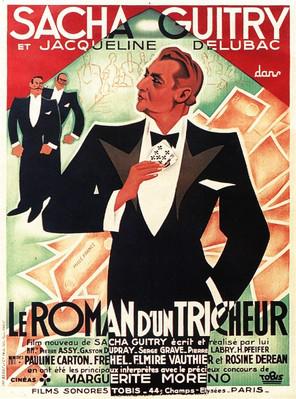Synopsis
Life story of a charming scoundrel, with little dialogue other than the star/director's witty narration. As a boy, only he survives a family tragedy when he's deprived of supper (poisonous mushrooms!) for stealing...concluding that dishonesty pays. Through years of dabbling in crime and amusing adventures, two women appear and reappear in his life, a dazzling blonde jewel thief and a stunning brunette gambler. Finally, he meets the mysterious Charbonnier who had saved his life in World War I, leading to the surprising next phase in his career...
Source : IMDb
Credits
Director (1)
Actors (14)
Production and distribution (3)
- Executive Producer : Cineas
- Film exports/foreign sales : Gaumont
- French distribution : Films Sonores Tobis
Full credits (9)
- Screenwriter : Sacha Guitry
- Dialogue Writer : Sacha Guitry
- Director of Photography : Marcel Lucien
- Music Composer : Adolphe Borchard
- Editor : Myriam
- Sound Recordist : Paul Duvergé
- Producer : Serge Sandberg
- Assistant Operator : Raymond Clunie
- Artistic Director : Henri Menessier
Technical details
- Type : Feature film
- Genres : Fiction
- Sub-genre : Drama
- Production language : French
- Production country : France (100.0%)
- Original French-language productions : Unspecified
- Nationality : 100% French (France)
- Production year : 1936
- French release : 19/09/1936
- Runtime : 1 h 21 min
- Current status : Released
- Visa number : 2004
- Visa issue date : 07/11/1941
- Approval : Yes
- Production formats : 35mm
- Color type : Black & White
- Aspect ratio : 1.37
- Audio format : Mono
TV broadcasting
This content is for registered users only.
Are you a member? Please login to view content.
News & awards
Selections (1)
About
Production
Most of the film takes place in flashback, with a voiceover narration by Guitry (in his role as the Cheat) in which he also speaks the dialogue of the other actors. Only in the 'present' scenes is any dialogue spoken by other actors (notably Marguerite Moreno). This technique of a voiceover narration which interprets the action has echoes of the 'film explainer' who was sometimes used to narrate silent films, and it has also been seen as a model for the type of narration used by Orson Welles in The Magnificent Ambersons. Guitry also used the spoken word to present the actors and technicians as they are introduced on-camera at the start of the film, instead of the conventional printed credits.
Reception
On its release in France, the film met with a mixed reception, but it subsequently maintained a reputation among critics and film-makers as one of Guitry's best films; in 2008 it was included in Cahiers du Cinéma's list of 100 most important films.
The film was released in the UK and USA, and enjoyed significant success. In London a reviewer for The Times commented on its elaborate narrative structure: "As always when the difficulties and disadvantages of a constricting technique are overcome, there is an effect of unity and precision which freedom cannot often give". When the film opened at the Academy Cinema in London in September 1937, it ran there for four months. Around the UK it was shown in 400 cinemas.[5] In the USA, the reviewer for The New York Times described it as "witty, impudent, morally subversive" and commented, "Only a man of Guitry's impudence could have succeeded in making 'The Story of a Cheat' the clever picture that it is".
Source : Wikipedia









































